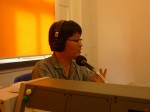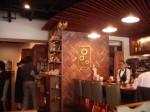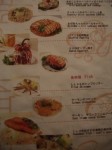Our talk with Barysiuk Viktoryia, a manager of a Belarussian restaurant called “Minsk”, continues. She explained the background to open the only Belarussian restaurant in Japan.
今週も先週に引き続き、地下鉄南北線・六本木一丁目駅近くにあるベラルーシ家庭料理店「ミンスクの台所」店長のバリシュク・ヴィクトリアさんをゲストにお迎えしました。今回は、日本で唯一のベラルーシ料理店を開店した経緯を中心にお聞きしました。
If you have been there, you already know that there are always many people. But you may wonder like, “Why is that restaurant so popular even though Belarussian cuisine is not well-known among Japanese?”
行かれたことのある方はご存知だと思いますが、ランチやディナー、いつの時間帯にお店に行っても、お客さんでいっぱいなんです。でも、こう聞くと不思議に思いませんか?「日本でほとんど知られていないベラルーシ料理のお店に、何でそんなにお客さんがたくさん来るの?」と。
But Viktoryia and the restaurant owner had the odds in their favor. There are many Russian restaurants but no Belarussian one at all in Japan. So they thought that they would be able to own the one and only restaurant.
It features Belarussian “home cooking”. It has no waiter – all of workers are women and creates homey mood. It’s located near the Russian embassy but located in Roppongi’s outlying area. It means they get many Russians and there are no other competitors around. Then they won popularity among people in Tokyo.
ヴィクトリアさん側には、2002年の開店前から勝算はあったようです。ロシア料理店はたくさんあっても、ベラルーシ料理店はゼロ。だからオンリーワンのお店になれる、という目論みがありました。
そして、家庭料理であることをアピールし、店員さんを全て女性にして温かみを演出。ロシア大使館が近くにありながらも、六本木の中心から少し外れているという絶妙な距離感も手伝って、お店の評判は人々に伝わっていきました。
But not all has been smooth sailing. They pulled dishes that Japanese didn’t like from their menu, but their recipes are not adapted to the Japanese palate at all. However, they bent the mind to “amount” of dishes. Russians and Belarussians think that guests have satisfied themselves if food is left on their plates. If they finish them up, they want to eat more. Viktoryia told me that a host cooks food for 40 people there if 20 guests come to a party there!
But the Japanese diet is totally opposite so they had to overcome the difference in food cultures. They poured food into a big bowl or dish first and tried to put it into a smaller one little by little.
しかし、全く苦労が無かったわけではありません。日本人にも受けるメニューを残しながら本場の味を貫き通した「ミンスクの台所」ですが、問題は料理の「量」。ロシア人やベラルーシ人は「出した料理を残したら”満足”のしるし。全部食べたら”物足りない”のしるし」という文化なのだそうです。例えばホームパーティに20人来るとしたら、パーティの主催者は40人分くらい食べ物を用意するそうなんです。
ところが、日本の食習慣は全く違いますよね。そのような大きな違いを克服するのに、本当に薄氷を踏む思いで、料理の量を少しずつ少しずつ調整していったそうです。

毛皮のコートを着た鰊(にしん)Fur-coated herring.
I would like to learn her philosophy of business. If she thought like, “If you like our cuisine, you can come. If you don’t, I don’t care because our dishes are not familiar to Japanese”, they couldn’t stay in business in Roppongi for almost 10 years.
I have much to learn from her strategies to spread the unknown to the unknown market, because I want to spread both website and radio of My Eyes Tokyo to people. I’ll keep learning from her… rather, I’m going to continue to have her dishes!
私自身、ヴィクトリアさんの商売哲学を是非勉強させていただきたいと思っています。もし「ベラルーシ料理を食べたい人だけが来ればいいよ。もともと、日本人には馴染みの薄い料理なのだから」と思って自己流を貫いていたら、とても六本木で10年近くも商売できなかったでしょう。
知られていないものを、未知のマーケットで広めていくために彼女が取った戦略は、今後My Eyes Tokyoのラジオ・サイト両方を広げていきたいと思っている私にとって、本当に学ぶべき点の多いものでした。これからも、勉強させていただきます・・・というか、食べに行かせていただきますね!





